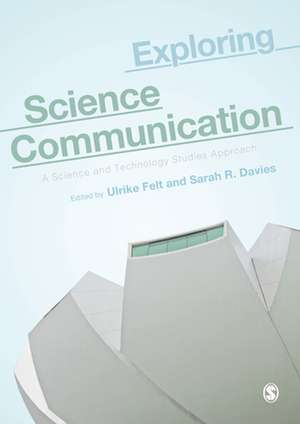Exploring Science Communication: A Science and Technology Studies Approach
Editat de Ulrike Felt, Sarah R Daviesen Limba Engleză Paperback – 19 feb 2020
- A focus on showing how to bring academic STS theory into your own science communication research
- Coverage of a range of topics and case studies illustrating different analyses and approaches
- Speaks to disciplines across Media & Communication, Science & Technology Studies, Health Sciences, Environmental Sciences and related areas.
| Toate formatele și edițiile | Preț | Express |
|---|---|---|
| Paperback (1) | 349.11 lei 3-5 săpt. | +22.71 lei 10-14 zile |
| SAGE Publications – 19 feb 2020 | 349.11 lei 3-5 săpt. | +22.71 lei 10-14 zile |
| Hardback (1) | 995.60 lei 6-8 săpt. | |
| SAGE Publications – 19 feb 2020 | 995.60 lei 6-8 săpt. |
Preț: 349.11 lei
Nou
Puncte Express: 524
Preț estimativ în valută:
66.82€ • 72.61$ • 56.17£
66.82€ • 72.61$ • 56.17£
Carte disponibilă
Livrare economică 29 martie-12 aprilie
Livrare express 18-22 martie pentru 32.70 lei
Preluare comenzi: 021 569.72.76
Specificații
ISBN-13: 9781526464408
ISBN-10: 1526464403
Pagini: 264
Dimensiuni: 170 x 242 x 18 mm
Greutate: 0.45 kg
Ediția:1
Editura: SAGE Publications
Colecția Sage Publications Ltd
Locul publicării:London, United Kingdom
ISBN-10: 1526464403
Pagini: 264
Dimensiuni: 170 x 242 x 18 mm
Greutate: 0.45 kg
Ediția:1
Editura: SAGE Publications
Colecția Sage Publications Ltd
Locul publicării:London, United Kingdom
Recenzii
Exploring Science Communication brilliantly demonstrates how Science Communication can be enhanced and elaborated through an engagement with Science and Technology Studies. Analytically and empirically, the volume traces the complex roles of Science Communication in the making and doing of science, publics and politics. Essential reading for both analysts and practitioners.
Science communication emerges as much more than getting new knowledge ‘out’ to larger society. Through a series of insightful contributions, science communication is revealed as shaping both science and society, re-imagining our socio-technical futures and creating narratives of governance, responsibility and change. Seen from an STS perspective, science communication ‘matters’ in important, challenging and unexpected ways.
Science communication emerges as much more than getting new knowledge ‘out’ to larger society. Through a series of insightful contributions, science communication is revealed as shaping both science and society, re-imagining our socio-technical futures and creating narratives of governance, responsibility and change. Seen from an STS perspective, science communication ‘matters’ in important, challenging and unexpected ways.
Cuprins
Chapter 1. Introduction
Part I – STS Concepts and Sensitivities
Chapter 2. Conceptual Framings: STS Research for Science Communication
Chapter 3. What does an STS approach to Science Communication Look Like?
Part II – Mobilizing STS Concepts and Sensitivities: The Case Studies
Chapter 4. Object Biographies: The Life of a Hacked Gene Gun - Tybjerg, Karin; Whiteley, Louise; Davies, Sarah R.
Chapter 5. Public Science and Public Space: Communicating Ecologies through Landscape Design - Owens, Marcus
Chapter 6. Visual Climate Communication: Making Facts and Concerns in Popular Science Magazines - Born, Dorothea
Chapter 7. Public Health Communication: Anecdotal Evidence and Responsibility in Print Media Accounts of Obesity - Felt, Ulrike
Chapter 8. Constructing Science in Public: Framing Synthetic Yeast in News Media - Szymanski, Erika
Chapter 9. Science, Emotion, and Identity Online: Constructing Science and Selves on “I Fucking Love Science” - Marsh, Oliver
Chapter 10. Coproducing Knowledge and Nation States: Nutrition Communication and the making of Citizens - Ben Shachar, Teharlev Erela; Davidovitch, Nadav
Chapter 11. Communicating Forensic Genetics: "Enthusiastic" Publics and the Management of Expectations - Amelung, Nina; Granja, Rafaela; Machado, Helena
Part III – Concluding Thoughts
Chapter 12. Connections, Assemblages, and Open Ends
Part I – STS Concepts and Sensitivities
Chapter 2. Conceptual Framings: STS Research for Science Communication
Chapter 3. What does an STS approach to Science Communication Look Like?
Part II – Mobilizing STS Concepts and Sensitivities: The Case Studies
Chapter 4. Object Biographies: The Life of a Hacked Gene Gun - Tybjerg, Karin; Whiteley, Louise; Davies, Sarah R.
Chapter 5. Public Science and Public Space: Communicating Ecologies through Landscape Design - Owens, Marcus
Chapter 6. Visual Climate Communication: Making Facts and Concerns in Popular Science Magazines - Born, Dorothea
Chapter 7. Public Health Communication: Anecdotal Evidence and Responsibility in Print Media Accounts of Obesity - Felt, Ulrike
Chapter 8. Constructing Science in Public: Framing Synthetic Yeast in News Media - Szymanski, Erika
Chapter 9. Science, Emotion, and Identity Online: Constructing Science and Selves on “I Fucking Love Science” - Marsh, Oliver
Chapter 10. Coproducing Knowledge and Nation States: Nutrition Communication and the making of Citizens - Ben Shachar, Teharlev Erela; Davidovitch, Nadav
Chapter 11. Communicating Forensic Genetics: "Enthusiastic" Publics and the Management of Expectations - Amelung, Nina; Granja, Rafaela; Machado, Helena
Part III – Concluding Thoughts
Chapter 12. Connections, Assemblages, and Open Ends
Descriere
The communication of scientific research raises big questions about the kind of societies we want to live in. Through a range of case studies, from museums to Facebook to public parks, Exploring Science Communication shows you how to understand and analyse the complex and diverse ways science and society relate in today’s knowledge intensive environments.
